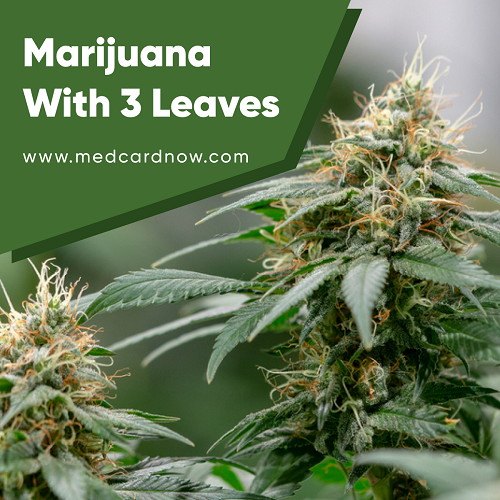
In this article, we are going to discuss the cause of marijuana with 3 leaves & also answer a common question how many leaves does marijuana have?
Each cannabis strain is unique, and some plants have more tips on their leaves than others. Most cannabis plants begin with 3 leaves when they are young. However, as they become mature, the leaves spread to have more points.
After germination, the leaves usually have a second set of 3-point leaves. From then onwards, the leaves normally have more than three points.
Cannabis plants have several numbers of points. However, the most common point is seven. Depending on the strain, you will see 5, 9, 11, or even 13 points which aren’t unusual. While these may be rare, occasionally marijuana plants have an even number of points, prompting the question of how many leafs does weed have.
Marijuana with 3 leaves might result from different growing conditions. Some plants will have more leaves depending on the environment. An ideal environment can lead to leaves with more points. These variations can include three leaf plants and those with a different number of points.
Nonetheless, some plants may have varying leaves even on the same plant.
Regardless, what if your marijuana plant grows with the normal 3-finger leaves? What does that mean?
What causes marijuana with 3 Leaves?
- Light stress: Light is an essential factor, and significant changes in grow light type or light levels can influence the leaves.
- Unexpected photoperiods: Switching grow lights on and off at a new time or changing the plant’s lighting schedule can also influence leaves. Sometimes marijuana with 3 leaves results from switching to a 12/12 light schedule.
- Environmental stress: High temperatures, stagnant air, underwatering, and other stress factors can lead to marijuana with 3 leaves.
- Re-vegetating: When a plant starts developing buds in the flowering stage before going to the vegetative stage, it can lead to marijuana with 3 leaves.
- Genetics: Marijuana with 3 leaves can be due to genetics. If your plants are healthy and still grow with 3-point leaves, then there’s no need to worry.
- 3 weed: This is a phenomenon where plants consistently produce 3-point leaves due to their adaptation to environmental changes or genetic predispositions.
- Pot plant leaf considerations: Ensuring that each pot plant leaf is healthy and free from stress is key to preventing abnormal leaf development.
- Leaf weed concerns: Monitoring the overall health of leaf weed can help gardeners adjust care practices to support normal growth.
Cannabis plants with 3-point leaves may also be because of a stress response. This response is usually a result of major changes in light quality or light schedule. For example, switching plants from fluorescent to powerful LED lights can lead to 3-point leaves. The major cause for this effect is because the plants adjusted to the light and started growing regularly. Additionally, when considering weed plant leaf health, recognizing three prong leaf formations can be crucial for diagnosing and correcting stress responses. Understanding how to distinguish between male female pot plants is also essential, as males tend to exhibit different growth patterns compared to females.
Why plants start growing 3-point leaves after a change in light can depend on the type of strain.
Changing the light schedule can also affect the number of leaves. Plants may grow 3-point leaves after switching their grow light or having irregular light schedules.
Outdoor growing comes with difficulties controlling mother nature. Natural factors like bush fires can cause plants to grow three point leaf. Bush fires create smoke that blocks the sun’s rays which leads to a 3-point stress response.
Plants growing 3-point leaves in response to stress will correct themselves after a while. All you need is time.
You might also want to know: How to Find a Marijuana Grower
My cannabis plant has leaves with 3 and 5 points. Is this bad?
No worries! Having cannabis leaves with 3 or 5 points is not necessarily a cause for concern. Cannabis plants can exhibit a range of leaf shapes and sizes, influenced by genetics, growing conditions, and environmental factors. While most cannabis plants typically develop leaves with 5 or 7 points as they mature, variations such as 3-point or 5-point leaves can occur naturally without indicating any underlying issues. Marijuanas plants leaf variations might include unique forms like the 9-leaf pot plant, especially noticeable in certain exotic strains. However, if accompanied by other symptoms such as discoloration, wilting, or stunted growth, it may be worth investigating potential causes such as nutrient deficiencies, pests, or environmental stressors. Leaf weed plant health is critical, and ensuring your cannabis is thriving under optimal conditions can prevent many common issues. Overall, the presence of leaves with 3 or 5 points alone is not indicative of a problem and is often just a natural variation within the plant species. Additionally, plants exhibiting weed three-point leaves might simply be responding to transient stress factors but can recover with proper care.
Read Also: What are the various forms of Cannabis?
Common Misconceptions About Cannabis Leaf Structures
When it comes to cannabis cultivation, understanding leaf structures is crucial, yet it is surrounded by numerous misconceptions. Here, we address some of the most common myths and provide clarifications to help both novice and experienced growers better understand the realities of cannabis leaf development.
Misconception 1: More Leaves Mean a Healthier Plant
- Reality: While a lush, leafy cannabis plant is visually impressive, the number of leaves is not a direct indicator of plant health. Health should be assessed based on the color, vigor, and resilience of the leaves rather than just their quantity. Some strains naturally produce fewer leaves but can still be perfectly healthy and productive.
Misconception 2: The Number of Leaf Points Indicates Potency
- Reality: There is a prevalent belief that the number of points (fingers) on a cannabis leaf correlates with the plant’s potency. However, potency is determined by the genetics of the plant and the concentration of cannabinoids like THC and CBD, not by the physical appearance of the leaves.
Misconception 3: Three-Leaf Plants Are Always Young or Unhealthy
- Reality: It’s true that most young cannabis plants start with leaves that have fewer points, typically three. However, if a mature plant exhibits three-point leaves, it doesn’t necessarily mean it is unhealthy. This trait can be a characteristic of the plant’s genetic makeup or a response to environmental stress, which, if managed properly, doesn’t have to impact the overall health or yield of the plant.
Misconception 4: Odd Number of Leaf Points is Unnatural
- Reality: Cannabis leaves with an even number of points, such as 4, 6, or 8, are less common than those with odd numbers like 5, 7, or 9. Nevertheless, variations in leaf point number can occur naturally due to genetic diversity within cannabis species. These variations are normal and do not typically indicate any genetic or health problems.
Misconception 5: Leaves with More Points Are Better for Cloning
- Reality: The suitability of a leaf for cloning does not depend on the number of points it has. Success in cloning is more about the overall health of the plant and the techniques used during the cloning process. A healthy plant with three-point leaves can be just as successful in cloning as a plant with multi-point leaves.
Optimizing Growing Conditions for Different Leaf Structures
Achieving optimal growth and health in cannabis plants involves understanding and adapting to the unique needs of different leaf structures. Each cannabis strain and its characteristic leaf structure may require slightly different environmental conditions to thrive. Here’s how to optimize growing conditions tailored to various cannabis leaf structures:
1. Light Requirements
- Balancing Light Intensity: Different leaf structures can indicate how a plant will respond to light. Plants with larger, broader leaves might need more intense light to penetrate through the foliage and reach lower buds. Conversely, plants with thinner or fewer leaves may require less intense light to avoid stress and leaf burn. Using adjustable LED grow lights can help in fine-tuning the intensity based on the plant’s response.
- Adjusting Light Schedules: Variations in leaf structure can also influence how plants respond to light schedules. Some strains with unique leaf patterns might benefit from longer light periods during the vegetative stage to encourage more robust growth, while others might need a shorter light period to initiate flowering effectively.
2. Watering Practices
- Monitoring Water Needs: Plants with denser leaf structures may transpire more and thus require more frequent watering. It’s important to adjust your watering schedule based on the plant’s uptake and the ambient humidity levels. Cannabis plants with fewer leaves might be more susceptible to overwatering issues, so it’s crucial to ensure good drainage and allow the soil to dry out slightly between waterings.
- Nutrient Delivery: The leaf structure can influence how effectively a plant absorbs and uses nutrients. A foliar feeding approach, where nutrients are sprayed directly onto the leaves, can be beneficial for plants with large leaf surfaces, ensuring that nutrients are more directly available where they’re most needed.
3. Humidity and Air Circulation
- Optimizing Humidity Levels: Cannabis plants with thick, dense leaves may require lower humidity levels to prevent mold and mildew, especially in dense canopies. In contrast, plants with sparser leaves might tolerate higher humidity levels. Keeping a hygrometer handy to monitor these levels and adjusting your dehumidifiers or humidifiers accordingly is essential.
- Enhancing Air Circulation: Good air circulation is crucial for maintaining plant health, particularly for those with complex leaf structures. Ensuring that air can flow freely between and around the leaves will help in reducing the risk of pests and diseases and assist in even growth.
4. Temperature Control
- Adjusting for Optimal Growth: Different leaf structures might require slight adjustments in temperature. Plants with thicker leaves generally can handle slightly higher temperatures because they store more moisture. However, maintaining a consistent temperature that does not fluctuate widely is key to preventing stress and promoting steady growth.
5. Stress Management
- Observing Plant Responses: Regularly check your plants for signs of stress, such as discoloration or wilting, which could be indicative of suboptimal growing conditions. Adjust your care regimen based on these observations to ensure each plant is supported in its growth environment.
Bottom line
Cannabis plants with 3-point leaves are uncommon and could indicate environmental stress, lighting changes, or genetic factors. Quickly identifying and addressing these changes is crucial for maintaining plant health. Effective management of growing conditions can enhance both the yield and quality of your plants.
For growers interested in optimizing their cultivation techniques or exploring medical marijuana’s benefits, MedCardNow provides expert guidance and support. Visit our website for detailed resources on obtaining your medical marijuana card and maximizing your cannabis garden’s potential.
Looking for a Medical Marijuana Card? We can HELP!
If you’re experiencing concerns about your marijuana plant’s growth patterns, you might also be interested in exploring the therapeutic benefits of medical marijuana for yourself. At MedCardNow, we specialize in helping individuals like you obtain medical marijuana cards and connect with licensed physicians who can provide personalized recommendations.
Ready To Get Started?
For a detailed, step-by-step guide on how to get your medical card with us with ZERO-Hassle, check out our comprehensive article- (How To Apply For Marijuana Medical Card).
Don’t let concerns about your marijuana plant’s growth overshadow the potential benefits of medical marijuana for your health. Contact MedCardNow today to learn more about our services and take the first step toward accessing safe, legal, and effective medical cannabis treatments.



